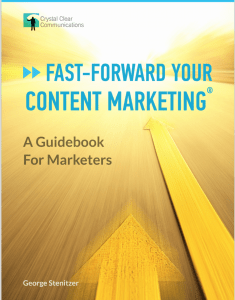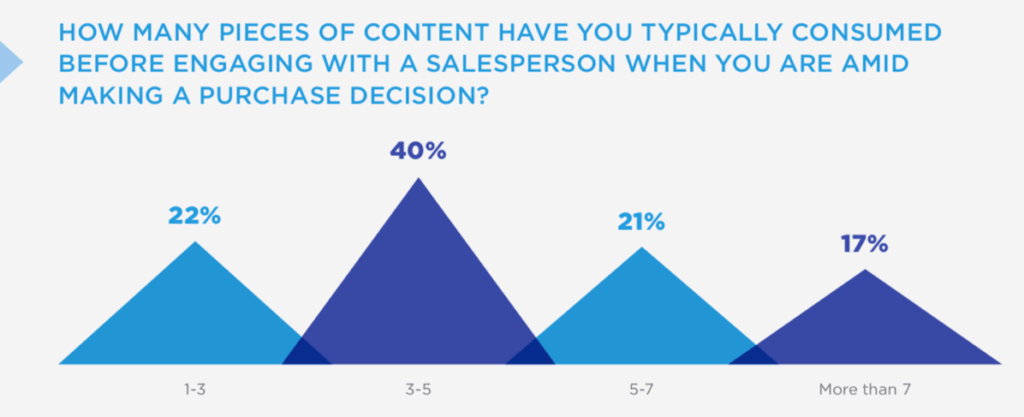
“How do you prove that an ungated content asset led to a sale?”
A marketer at SAP Concur asked this question, which is one of the Top 100 questions on content marketing. How do you prove that an ungated content asset led to a sale?
Marketers wonder when to gate or ungate content
Marketers at Cisco, Exxon Mobil, the Segal Group, GoGo, MSC Industrial, Sherwin Williams and the US Postal Service asked related questions about gated and ungated content assets.
Whether or not to gate content is a common dilemma, because an estimated 80% of B2B content assets are hidden behind a gate.
Approach the question of gated content from a buyer’s viewpoint
Isn’t it annoying when the pop-up appears even before you’ve decided whether the content is worth a download? Or when you need a piece of content, but it’s hidden behind a gate?
To get through a gate, you’re usually forced to give up your name and email — maybe even more.
So you fill in the form. Or maybe you don’t. Those who don’t represent lost opportunities for content marketers.
Once you ask a buyer to go through all that fuss, the content on offer had better be good. Nothing is more disappointing than giving up your contact information for a piece of content you read and delete the same day.

Full disclosure: at Crystal Clear Communications, we rarely use a gate. That said, our 35-page guidebook, Fast-Forward Your Content Marketing, is gated content.
Marketing guru Heidi Cohen shows how an ungated content asset can lead to sales
Cohen notes that, based on internal data, the average sale at Moz involves 5 to 8 customer touches, according to Rand Fishkin. This data point comes with a caveat: It’s based on digital interactions only and it may measure only one individual, computer and/or log-in at a company.

That means it may undercount the true number of prospect touches since other decision-makers, devices and offline interactions may have been involved but didn’t get captured.
Cohen offers 3 ideas to attribute sales to an ungated content asset:
- Insert a contextually relevant call-to-action (CTA) with a tailored UTM (urchin tracking module). Here’s how.
By doing so, you enable Google Analytics to see where that click comes from. So you can track specific calls-to-action within your content and even across platforms. - Add chatbot functionality to ungated content. This move enables you to direct readers to specific next steps.
Further, as Drift has proven, by ungating your content you expand its potential to attract readers. In turn, you can lift response rates. (Note: chatbots like Drift, which run on artificial intelligence (AI), are a form of voice-first technology.)
- Guide buyers to take the next step towards improved relationships and a purchase. Offer customers the information they need to keep them engaged.
How? By incorporating content off-ramps or connected content inside your content assets. Help readers to continue engaging with your content in the way that they choose.
“At its best, connected content pulls your reader out of her passive reading mode and encourages her to act,” Cohen says.
On a carefully considered purchase, both consumers and businesses consume lots of content before reaching out to sales. A DemandGen study showed that 4 out of 5 buyers consume 3 or more pieces of content before contacting Sales.

The more gates they hit, the harder it is for buyers to consume that much content.
If you buy the logic of ungating content, how to get your CMO aboard?
To gain buy-in, propose an A/B test – for example, a product launch with and without gated content. You’ll find out how well each approach works with your particular customers.
Or, use the ultimate gate: Require customers to meet with Sales (virtually or live) in order to get all the information they want.
That’s the approach we took at Tellabs when we released a controversial industry analyst study full of bad news for our customers entitled, “The End of Profitability.”

We publicly distributed a news release, 2-page executive summary, infographic and video. But only customers who agreed to meet with Sales could get their hands on the full 100-page report with all the details and data.
Helping Sales get a foot in the door with new customers like Telefonica and Google proved to be a game-changer for Tellabs. It strengthened Sales support for Marketing. And it led to Tellabs winning a Content Marketer Award from the Content Marketing Institute.
Need answers to #contentmarketing questions? You’ll find the answers to the Top 100 Questions on Content Marketing here.






